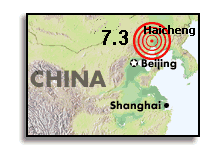Haicheng, China 1975

Instruments
Seismologist use a variety of instruments
to monitor earthquake prone areas. Seismometers measure the abrupt
oscillations of the earth.
Creepmeters measure the relative displacement
between two points on opposite sides of a fault line. The distance
between the two reference points is typically 3 meters. Creep
is a slow movement. For example, the relative displacement across
the San Andreas Fault is 1.5 centimeters per year, as measured
near Hollister, California. Reference: Bruce A. Bolt, Earthquakes,
Freeman, New York, 1988.
Geodimeters are laser-based instruments
which measure the relative displacement between mountain tops
on opposite sides of a fault line.
Seismologist can sometimes predict the
time and location of earthquakes based on measurements from these
instruments.
Haicheng Earthquake
For example, seismologists noted increasing
seismic activity in Liaoning Province, China in 1975. The activity
occurred near the cities of Haicheng and Yingkow.
The seismologists sent out warnings days
before the February 4, 1975, earthquake of magnitude 7.3. The
people in nearby cities remained outdoors, despite the cold weather.
As a result, many lives were saved. Reference: M. Levy and M.
Salvadori, Why the Earth Quakes, Norton, London, 1995.
Nevertheless, there have been some "false
alarms" over the years. Furthermore, many earthquakes occur
without any notable precursor signs.
_______________________________________________________________________________________________
Please send comments and questions to Tom
Irvine at: tomirvine@aol.com

